 Roland
Roland
Roland's first venture into the PC audio market was with the MT-32 (Multi-Timbre 32) in 1987, with a retail price of $695. This was an external music synthesizer, and so required an interface card to connect to inside the PC. Later Roland released the "MT-32 on a card" in the form of the LAPC-I. It got 32 channels, and 128 built-in instruments and 30 drums. Owners could load their own instruments (patches) as well. Other external modules were released, including the CM-32L, CM-64, MT-100 and CM-500. Apart from the LAPC-I, all these needed to be connected to an interface card or sound card in the PC that had an "MPU-401" interface connector. None of these models were "MIDI"-compatible as they predate the General MIDI standard. See my separate article on getting sample sound onto your PC.
MT-32 (1987)
 Roland's first external music synthesizer box, which required an MPU-401 interface on your PC's sound card (or a separate interface card entirely). The MT-32 wasn't developed for the home computer market - it was supposed to be a synthesizer expansion unit for professional musicians.
Roland's first external music synthesizer box, which required an MPU-401 interface on your PC's sound card (or a separate interface card entirely). The MT-32 wasn't developed for the home computer market - it was supposed to be a synthesizer expansion unit for professional musicians.
With capability to output up to 32 voices simultaneously, it supported Roland's "LA" format - Linear Algorithmic. The MT-32's signal-to-noise ratio made it unsuitable for professional use, but it found favour among PC gamers of the mid-to-late 80s and early 90s and was supported by many games of the era.
Two variants of the MT-32 exist which are often classified as MT-32 "Old" and MT-32 "New". These can be distinguished by the presence (or lack of) the headphone jack on the rear panel. The "Old" did not have this whereas the "New" did. The sound output differs slightly between these two variants due to the fact that on the "New" variant, Roland moved the locations of some of its built-in instrument samples to be closer to what would become the General MIDI standard. This meant that some PC games only sound 'right' on the MT-32 variant that was around at the time the game music was composed. The "New" has a slightly less noisy output.
Roland later released a MIDI file that contained SysEx (System Exclusive) messages that will reconfigure these synthesizers to make them somewhat compatible with GM. The file MTGM.MID needs to be sent to the synthesizer using a MIDI player capable of sending SysEx messages.
MT-32 Revisions
There were several revisions of the MT-32 during its production lifetime, some subtle and some less so. In a nutshell, they are:
MT-32 Rev. 0 (also referred to as the MT-32 "old")
Identifiable by checking the rear of the unit. If it doesn't have a headphone jack, it's an MT-32 "old".
These also came in two PCB (printed circuit board) versions. The version 0 PCBs were those fitted to MT-32s with serial numbers from 851400 to 950499 while version 1 PCBs were fitted to serial numbers from 950500 onwards.
Version 0 PCBs had the main LA32 chip in a PGA (pin grid array) package. These PCBs only accept control ROM v1.xx. All these PCBs also have v2.0.0 of the reverb ROM (16 KB in size).
Version 1 PCBs had the main LA32 chip in a 100-pin QFP package. These PCBs only accept control ROM v2.xx. Some of these Version 1 PCBs also have the same v2.0.0 of the reverb ROM as in v0 PCB, whilst others have v3.0.0 of the reverb ROM which is 32 KB in size.
Ignoring the reverb ROM, the control ROM versions that exist are:
v1.0.3 - thought to be a prototype
v1.0.4 - dated 14th July 1987. Initial release.
v1.0.5 - dated 6th August 1987. Volume knob changes are now interpolated as opposed to directly applied to the data, allowing for much smoother volume changes when using the knob .
v1.0.6 - dated 31st August 1987. Rhythm selection Bender Control is now reset when MIDI All parameter reset is recieved, and when MT-32 Active Sensing is not received. Displays will not change, even when a Display Change exclusive MIDI message is recognized, unless the current mode is Master Volume input mode (e.g. Power-up default).
v1.0.7 - dated 10th October 1987. Fixes a bug related to specific values in uninitialized sram on startup causing the unit to act bizarre.
v2.04 - dated 11th November 1988. Unknown (possibly the first 2.x MT-32 ROM. Contains changes boosting the level of the LA32 chip to de-necessitate the 14-bit hardware DAC-hack, and changes related to the demo mode expanded ROM, and the changed hookup of the volume knob, and possibly other changes related to the MT-32 2.x PCB)
v2.05 -
v2.06 -
v2.07 - dated 23rd May 1990.
Blue Ridge (for MT-32 "old" only) (1988) - also requires the battery-backed RAM hack, otherwise has no effect. Believed to be based on the v1.0.4 or v1.0.6 Control ROM.
You can determine which control ROM version is installed by pressing and hold buttons '4', 'Rhythm' and 'Master Volume' while switching the MT-32 on. The version number will be displayed on the front panel. Ultimately there is no material difference in the way any of these Rev. 0 boards sound.
MT-32 Rev. 1 (also referred to as MT-32 "new")
Identifiable by checking the rear of the unit. If it has a headphone jack, it's an MT-32 "new". The key differences between Rev. 0 and Rev. 1 are:
- Fixed problem that caused Exec. Checksum Error and Exec. Buffer Overflow messages - these were common when using a Rev. 0 MT-32 with a faster PC (above 486 era), since the speed the PC would send messages to the MT-32 was too fast for it to handle.
- Faster CPU (Intel P8098 replaces the Intel C8095).
- Demo mode - a larger ROM is fitted which contains some built-in songs.
- Lower noise.
- Subtle differences in what you see on the LCD display
- Volume dial reacts a little differently
All these got the version 1 PCB, and so will only accept ROM v2.xx (see further up for the different v2.xx ROMs).
Unfortunately, there are audible differences in a number of games that were designed to play on the original MT-32 (Rev. 0). When Roland designed the Rev. 1, they fixed several bugs that games programmers had deliberately exploited in Rev. 0 to make the game sound the way it did. These games are known to hang or crash when played back through a Rev. 1 MT-32. Furthermore, Rev. 1 was designed when the MIDI standard was starting to take shape, so Roland moved a number of the default sound samples around within the sound bank. The result of this is that when playing some games whose music was composed on the Rev. 0 MT-32, some [default] sound samples will seem out of place when played through a Rev. 1 MT-32.
I cover this unit in quite a bit of detail on my main PC MIDI page.
Audio from the Roland MT-32 can be listened to on the following game pages:
You can also compare the audio output of the MT-32 side-by-side with numerous other sound cards and external MIDI synthesizers in my Sound Blaster 16 CT2770 Retro Review.
MT-100 (1988)
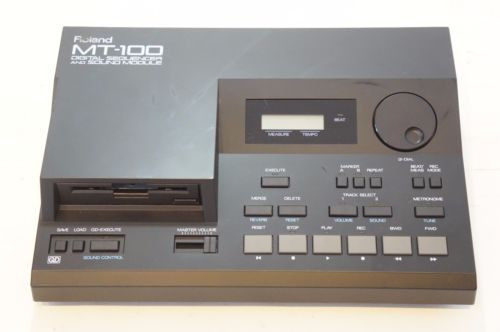
The MT-100's MT-32 circuitry is essentially identical to an MT-32 "New", and cannot be distinguished from an MT-32 "New" in any way.
The MT-100 has several useful settings that can be enabled/disabled using a combination of the buttons:
MIDI THRU ON/Off: Stop + BEAT/MEAS = Select this option with the turn dial, then press Execute. You can use FWD/BWD to select other options as well. Store this change as the default by holding the REC button while you press Execute.
All Clear: Stop + Delete, then press Execute
All Reset: Sound Control + Delete, then press Execute
Select Patches for each Instrument: Sound Control + Sound, then BWD or FWD, then Dial, then Execute
Select Volume for each Instrument: Sound Control + Volume, then BWD or FWD, then Dial, then Execute
Play Demo: Sound Control + Play, (Use the wheel to select a specific song) then Play
CM-32L (1989)
Roland launched their "CM" (Computer Music) range after seeing a good amount of success in the PC gaming industry with their MT (Multi Timbre) range. They realised the MT-32 was too expensive for most consumer PC gamers, and the CM range was introduced to remedy that. The "L" means the CM-32L uses "Linear Algorithmic", aka "LA" synthesis, just as with the MT-32.
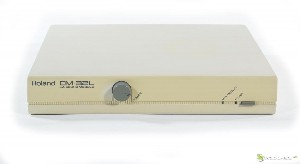 An external synthesizer box compatible with MT-32. Unlike the MT-32, the CM32-L only has a volume control, a MIDI message area, and power-on indicator.
An external synthesizer box compatible with MT-32. Unlike the MT-32, the CM32-L only has a volume control, a MIDI message area, and power-on indicator.
The CM32L has a maximum polyphony of 32 voices spread over nine parts. Eight of these parts are "instrument" parts, with the ninth dedicated as a "rhythm" section.
The CM-32L went one better than the MT-32, however, in that it added a further 33 samples in its wave "sound banks", although most of these were sound effects, not sampled instruments. Examples of these sfx are a dog barking, thunder, footsteps, laughing, punch, and scream. Signal-to-noise was again reduced over the MT-32.
The CM-32L has 128 presets and a built-in reverb (which is supposedly very good, even by modern standards).
A CM-32P was also released which was designed more for musicians. The "P" meant that instead of using "LA" synthesis, it used PCM wave table synthesis. On the front of the CM-32P was a PCM wave card slot to allow the user to expand the sample set with Roland PCM wave cards which are designed for use with the Roland U110 sample player.
At launch, the CM-32L retailed for £369 in the UK, and around $500 in the USA. The CM-32P went for £445.
LAPC-I (1989)
 Often mis-spelled LAPC-1, the LAPC-I is a self-contained PC sound card with the MT-32 innards on-board. "LA" stands for Roland's "Linear Algorithmic". Basically, it's a CM-32L on an ISA bus card.
Often mis-spelled LAPC-1, the LAPC-I is a self-contained PC sound card with the MT-32 innards on-board. "LA" stands for Roland's "Linear Algorithmic". Basically, it's a CM-32L on an ISA bus card.
The card can connect to an optional Roland MCB1 MIDI interface (£79 at launch), which adds a MIDI In, two MIDI Out, and a Sync socket. The MCB1 also provides a Metronome, and Tape In and Tape Out sockets.
Since the CM-32L is fully MT-32 compatible, this card is highly prized by retro PC gamers, as it not only supports both MT-32 and CM-32L-compatible games, but more crucially it eliminates the need for any MPU-401 interface or sound card MIDI port, making it fully compatible with *all* MT-32 and CM32-L titles out of the box - many MT-32 owners use their sound card's rather limited UART-only MIDI port which don't work on the older MT-32-compatible titles. To get around this you can use SoftMPU or get buy a modern physical unit called HardMPU.
At launch, the LAPC-I retailed for £379 in the UK and $450 in the USA without the optional MIDI interface.
The LAPC-I is the older system, and contains an eight voice synthesizer with 128 instruments, a rhythm voice with 34 sounds and 33 sound effects. One thing the LAPC-I can't cope with is digitised sounds, although the range of built-in sound effects covers commonly used noises like explosions and a pistol. Although the lack of digitised sounds may seem like a severe limitation, you have only to listen to the sound that games like Monkey Island II get out of this card to recognise what puts Roland's devices into a different price bracket." PC Review, November 1992
CM-64 (1989)
 Same as CM-32L, but has additional CM-32P (PCM synthesis) circuitry. No DOS games are known to support the CM-32P features. It is fully MT-32 compatible (more specifically, likely MT-32 "New" compatible). It has the same PCM wave card slot on the front as the CM-32P.
Same as CM-32L, but has additional CM-32P (PCM synthesis) circuitry. No DOS games are known to support the CM-32P features. It is fully MT-32 compatible (more specifically, likely MT-32 "New" compatible). It has the same PCM wave card slot on the front as the CM-32P.
It provides a total of 14-part multitimbral capacity plus a "rhythm" part. The eight "LA" sounds are played on MIDI channels 2 through 9 with the rhythm section on 10, while the PCM sampled sounds are on channels 11 through 16.
It retailed at over $1,000 at launch in the US, or £789 in the UK.
CM-500 (1991)
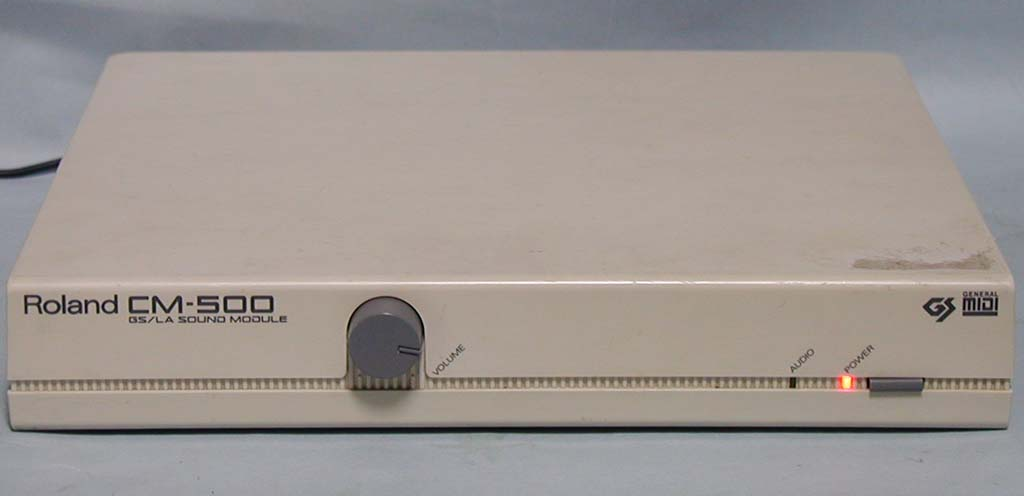 A combined CM-32L and CM-300 (a barebones SC-55 - see below). A switch on the back of the CM-500 allows you to select whether the device will work in (1) CM-32L mode, (2) CM-64 mode, (3) CM-300 only (great for games that suppot General MIDI) or (4) CM-300 + CM32L.
A combined CM-32L and CM-300 (a barebones SC-55 - see below). A switch on the back of the CM-500 allows you to select whether the device will work in (1) CM-32L mode, (2) CM-64 mode, (3) CM-300 only (great for games that suppot General MIDI) or (4) CM-300 + CM32L.
SC-55 (1991)
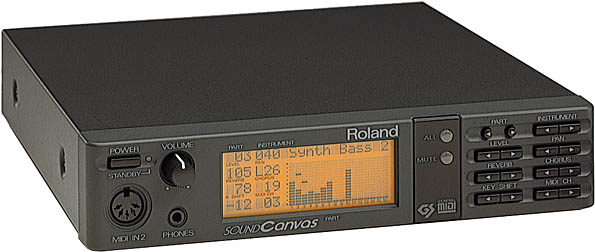 Roland's first General MIDI external music processor, the Sound Canvas 55 was the standard on which many games from 1991 onwards were written. It supports both General MIDI and Roland's superset of it, GS.
Roland's first General MIDI external music processor, the Sound Canvas 55 was the standard on which many games from 1991 onwards were written. It supports both General MIDI and Roland's superset of it, GS.
You can also compare the audio output of the SC-55 side-by-side with numerous other sound cards and external MIDI synthesizers in my Sound Blaster 16 CT2770 Retro Review.
Mk.I Owners Manual
Service Notes
SCC-1 (1992)
Price when New: $499, later $300
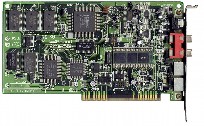 Designed to be for professional musicians. An SC-55 integrated onto an 8-bit PC card. Roland's first card to support their extension of the General MIDI standard, "General Synthesizer" (GS). 24 channels, 4 MB sample ROM containing 317 sounds (version 1) and 354 (version 2), mixed in 44 kHz (CD quality). MPU-401-compatible interface onboard. It could also run in MT-32 compatibility mode, but no samples could be uploaded (which a lot of games did), so not particularly suitable for PC gaming. Added chorus capability which was lacking on the LAPC-I.
Designed to be for professional musicians. An SC-55 integrated onto an 8-bit PC card. Roland's first card to support their extension of the General MIDI standard, "General Synthesizer" (GS). 24 channels, 4 MB sample ROM containing 317 sounds (version 1) and 354 (version 2), mixed in 44 kHz (CD quality). MPU-401-compatible interface onboard. It could also run in MT-32 compatibility mode, but no samples could be uploaded (which a lot of games did), so not particularly suitable for PC gaming. Added chorus capability which was lacking on the LAPC-I.
Computer Gaming World, October 1993
Rich Heimlich said: "Costly, but the industry standard for GM. If you want to know how a game was intended to musically sound, this is usually the only way to be sure. The lack of digital capability is one of its very few drawbacks.", scoring it 10 out of 10 for music quality.
Sound quality from this board is second to none.
SC-7 (1992)
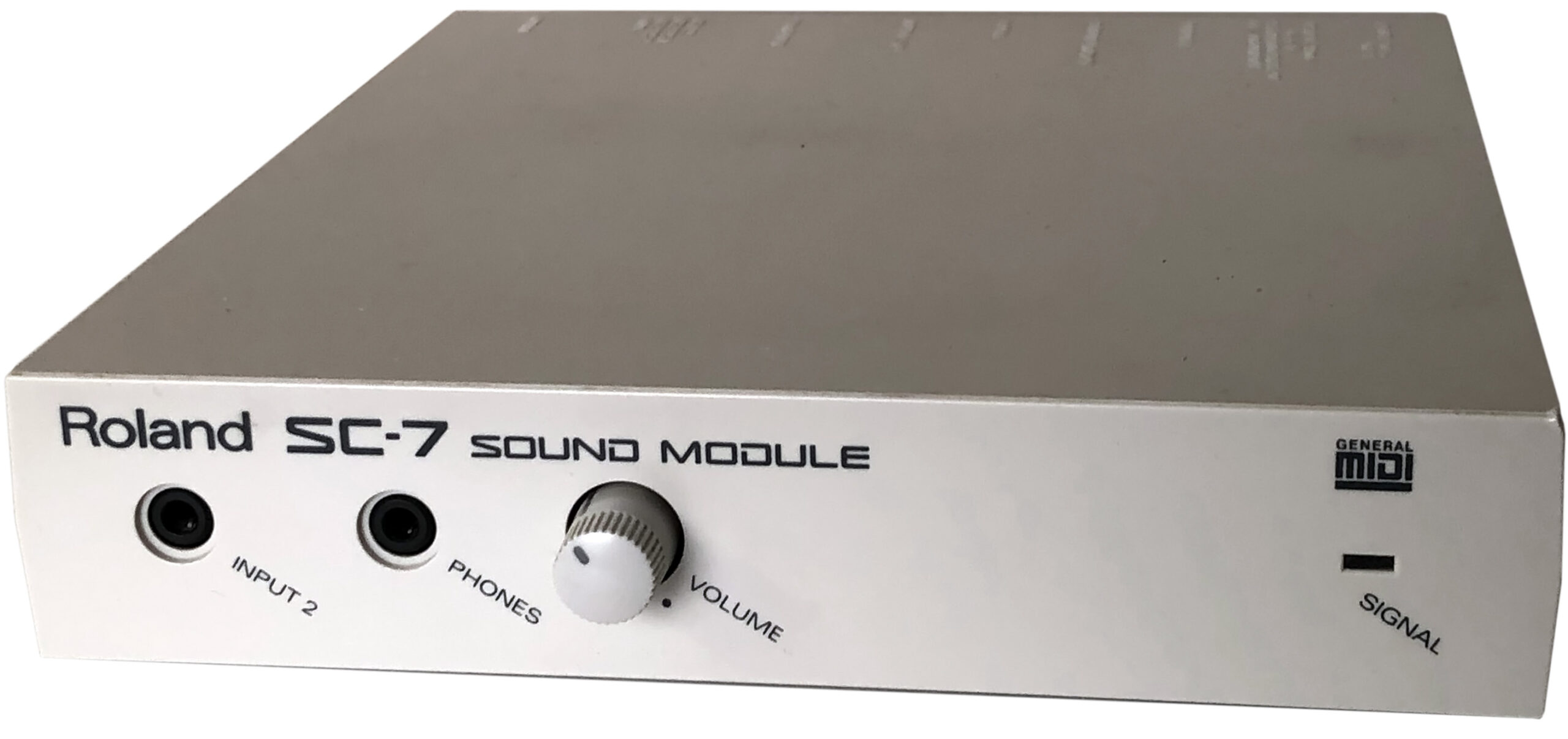 A cut-down sound module that supports General MIDI only. Unlike the SC-55, there is no MT-32 mode nor support for Roland's GM extension, GS). It provides up to 28 voices (channels) with 128 sounds and 6 drums in the onboard ROM. The sames are 16-bit at 32 kHz. It can also perform chorus, reverb and delay effects.
A cut-down sound module that supports General MIDI only. Unlike the SC-55, there is no MT-32 mode nor support for Roland's GM extension, GS). It provides up to 28 voices (channels) with 128 sounds and 6 drums in the onboard ROM. The sames are 16-bit at 32 kHz. It can also perform chorus, reverb and delay effects.
The same synthesizer was also used in the SCB-7, a wavetable daughterboard.
In Japan, it retailed for 42,000 Yen when first introduced.
SC-55 Mk II (1993)
 Enhanced version of the original SC-55, with support for 28 voices (up from 24), more patches (now up to 354 instruments), and improved audio circuitry (18-bit as opposed to 16-bit). It also adds a serial port as an alterative means of interfacing with the MPU-401.
Enhanced version of the original SC-55, with support for 28 voices (up from 24), more patches (now up to 354 instruments), and improved audio circuitry (18-bit as opposed to 16-bit). It also adds a serial port as an alterative means of interfacing with the MPU-401.
An SC-55ST version was released 2 years later that got rid of the LCD screen (no front panel editing functionality) and MIDI OUT and THRU ports.
Mk.II Owners Manual
Mk.II Service Manual
SC-50 (1993)
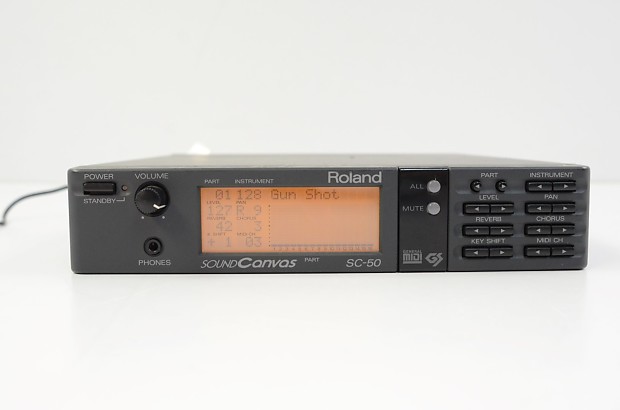 Basically a cut-down SC-55 Mk II without the second MIDI input on the front.
Basically a cut-down SC-55 Mk II without the second MIDI input on the front.
RAP-10 (1993)
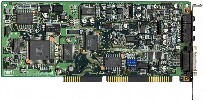 The first 'consumer' GM card from Roland, the RAP-10 sold for $599 when new. RAP stands for 'Roland Audio Production'. MIDI capability comprised 128 instruments (based on the SC-7 module) as could operate 24 individual digital channels of true 16-bit sound.
The first 'consumer' GM card from Roland, the RAP-10 sold for $599 when new. RAP stands for 'Roland Audio Production'. MIDI capability comprised 128 instruments (based on the SC-7 module) as could operate 24 individual digital channels of true 16-bit sound.
The RAP-10 did not have any support for Ad Lib or Sound Blaster modes. It was intended to be supported only in Windows games.
The RAP-10 entirely omits a CD-ROM interface. The RAP-10's sound quality didn't quite match that of the Turtle Beach MultiSound, but it was generally superior to the more mainstream boards we tested. Frequency response and channel separation were very good. Signal-to-noise ratio was high and distortion was minimal at maximum output levels, although at our midrange test levels the results were only average.
When playing back MIDI files, we were impressed by the realism of the sound, thanks largely to Roland's custom wavetable-based Sound Canvas chip set and DSP. The board also supports special effects such as chorus, reverb, and delay in hardware. Our playback tests, however, uncovered unexpectedly high distortion levels in digital playback mode.
The RAP-10 offers a stereo microphone input that can be switched under software control to handle a second line-level source. The board doesn't provide a power amplifier on-board, so you'll either have to use powered speakers or hook the output to an audio amplifier of your own.
Installing the RAP-10 means setting jumpers for the board's one required IRQ and two required DMA channels. (The default settings worked in our test-bed system.) The installation software checks the system for resource conflicts but doesn't give you a list of available resources up front.
Roland includes Roland Audio Tools, a version of Midisoft's Sound Impression software that's been specifically optimized for the RAP-10. Roland Audio Tools provides convenient controls and powerful editing functions with the familiar "rack mounted" interface. The included WaMI Mixer software lets you mix and sequence .WAV and MIDI files, too."
PC Magazine, April 1994
SC-88 (1994)
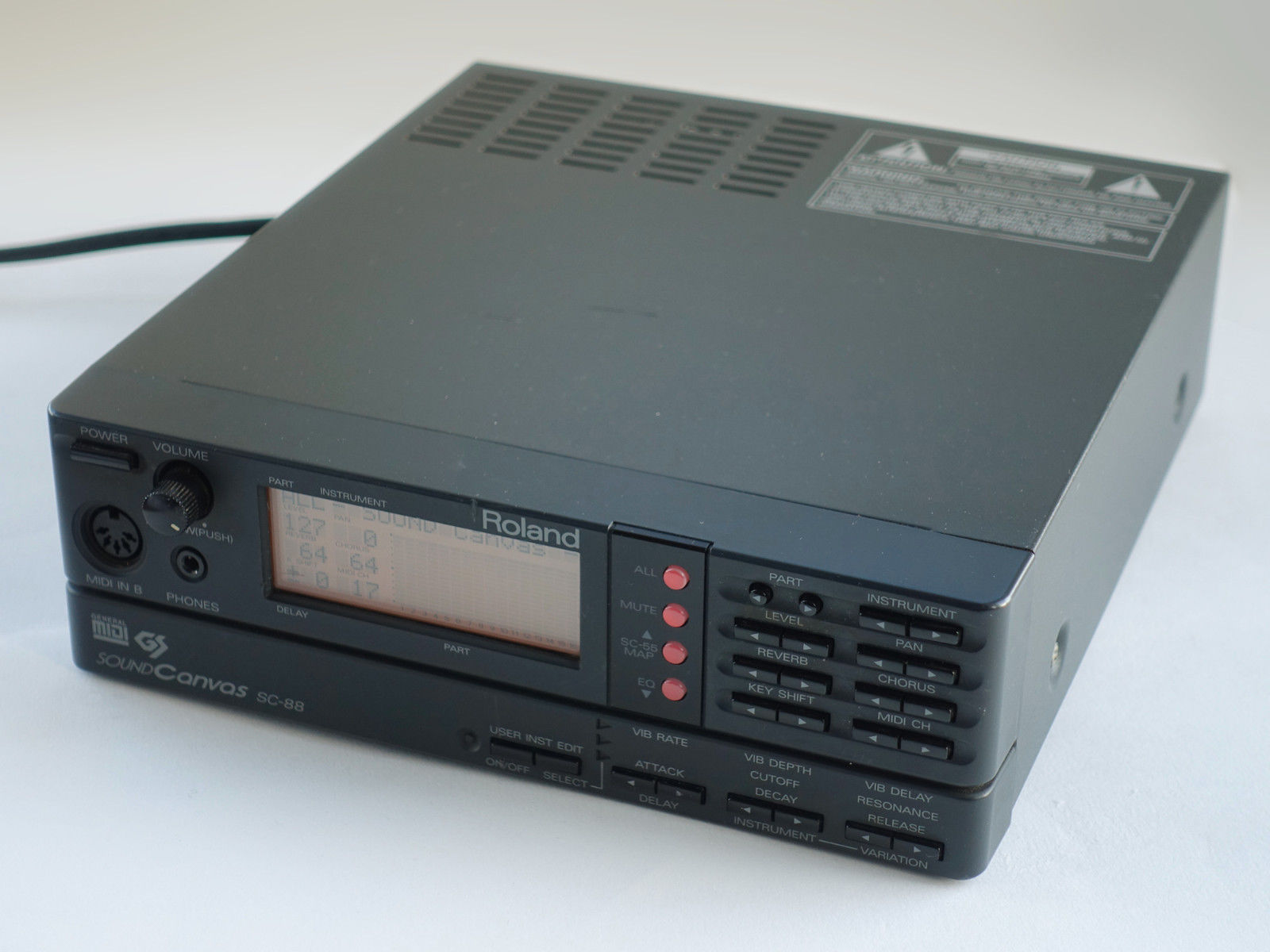 Similar to SC-55 Mk II, but has 654 instrument patches, and adds EQ functions. Fully GM and GS compatible, the SC-88 can be put into SC-55 map mode for backward compatibility.
Similar to SC-55 Mk II, but has 654 instrument patches, and adds EQ functions. Fully GM and GS compatible, the SC-88 can be put into SC-55 map mode for backward compatibility.
The SC-88 was in direct competition with the Yamaha MU80, also launched in 1994.
SC-88 Pro (1995)
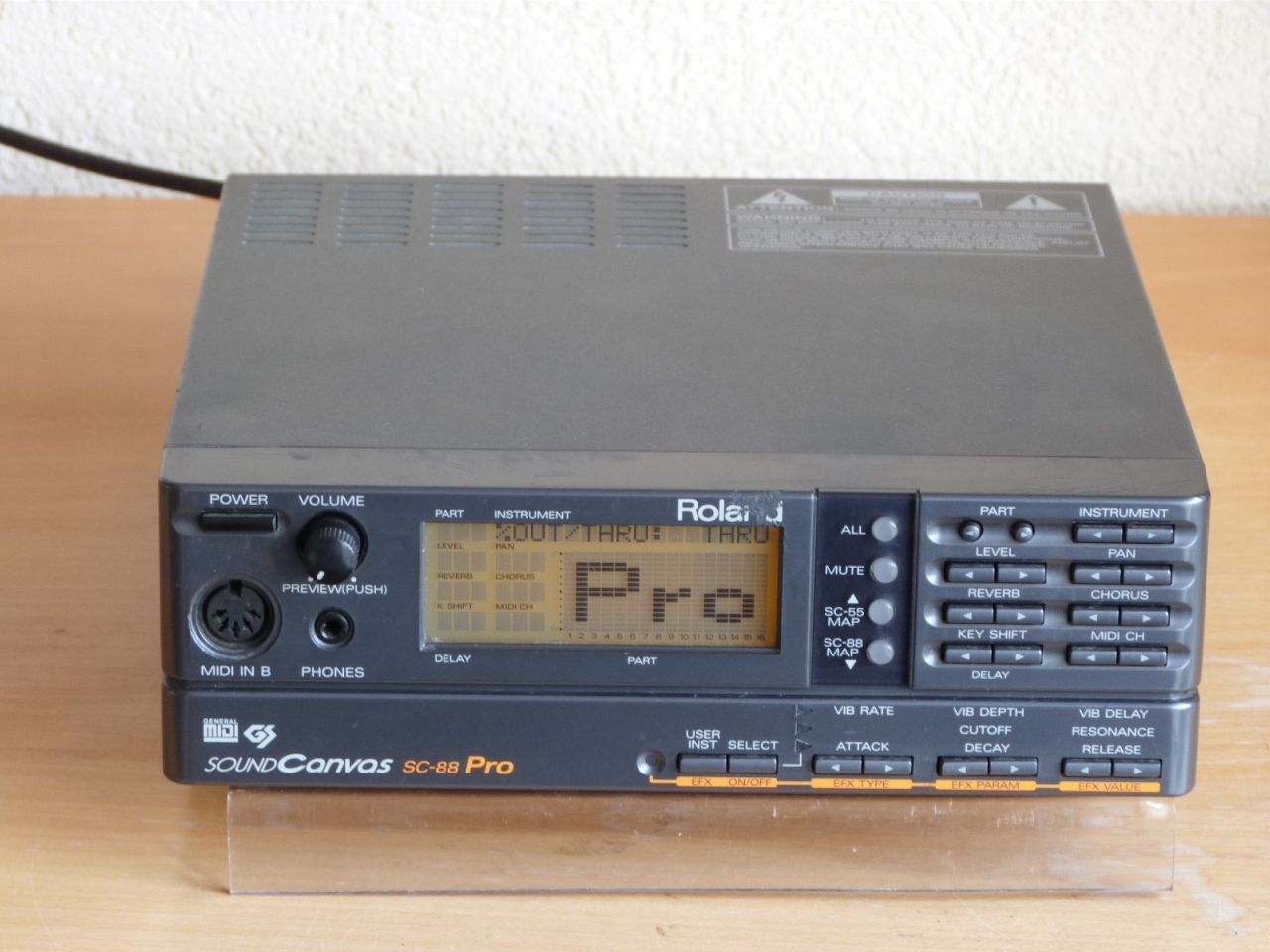 Similar to SC-88 but adds unofficial Yamaha XG compatibility. The Pro came with 910 instrument patches built-in.
Similar to SC-88 but adds unofficial Yamaha XG compatibility. The Pro came with 910 instrument patches built-in.
An SC-88VL model was released the same year which reduced the SC-88 Pro back into a single '1U' height by removing the user-editable program memory functions (and buttons).
An SC-88ST was released the year after the SC-88 Pro - it removed the LCD display completely.